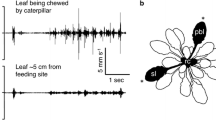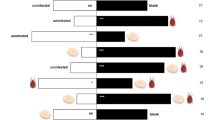Abstract
Volatile compounds elicited by insect herbivore feeding damage in five cotton cultivars and one naturalized cotton variety were examined by allowing beet armyworm larvae to feed overnight on leaves and collecting volatiles from the plants in situ. Of 23 compounds identified from larval damaged leaves, terpenes and lipoxygenase-hydroperoxide lyase-derived volatiles predominated. No pronounced differences in the levels of volatile emission were noted from leaves of undamaged plants of the different varieties. However, average volatile emission from damaged leaves of the naturalized variety was almost sevenfold higher than from damaged leaves of the commercial cultivars. This was despite the fact that larvae preferred feeding on the leaves of commercial cultivars over those of the naturalized variety in choice tests.
Similar content being viewed by others
References
Chang, J.F., Benedict, J.H., Payne, T.L., andCamp, B.J. 1988. Volatile monoterpenes collected from the air surrounding flower buds of seven cotton genotypes.Crop Sci. 28:685–688.
Dicke, M., Sabelis, M.W., Takabayashi, J., Bruin, J., andPosthumus, M.A. 1990. Isolation of volatile kairomone that affects acarine predator-prey interactions. Involvement of the plant in its production.J. Chem. Ecol. 16:381–396.
Dickens, J.L. 1990. Orientation to host plant and conspecifics by the boll weevil,Anthonomus grandis Boh. (Coleoptera: Curculionidae) Electrophysiological and behavioral correlations.Symp. Biol. Hung. 39:103–110.
Elzen, G.W., Williams, H.J., and Vinson, S.B. 1984. Isolation and identification of cotton synomones mediating searching by parasitoidCampoletis sonorensis.J. Chem. Ecol. 10:1251–1264.
Elzen, G.W., Williams, H.J., Bell, A.A., Stipanovic, R.D., andVinson, S.B. 1985. Quantification of volatile terpenes of glanded and glandlessGossypium hirsutum L. cultivars and lines by gas chromatography.J. Agric. Food. Chem. 33:1079–1082.
Farmer, E.E., andRyan, C.A. 1990. Interplant communication: Airborne methyl jasmonate induces synthesis of proteinase inhibitors in plant leaves.Proc. Natl. Acad. Sci. U.S.A. 87:7713–7716.
Gäbler, A., Boland, W., Preiss, U., andSimon, H. 1991. Stereochemical studies on homoterpene biosynthesis in higher plants; mechanistic, phylogenetic and ecological aspects.Helv. Chim. Acta 74:1773–1789.
Gueldner, R.C., Thompson, A.C., Hardee, D.D., andHedin, P.A. 1970. Constituents of the cotton bud. XIX. Attractancy to the boll weevil of the terpenoids and related plant constituents.J. Econ. Entomol. 63:1819–1920.
Harborne, J.B. 1988. Introduction to Ecological Biochemistry, 3rd ed. Academic Press, New York. pp. 147–185.
Hastanaka, A., Kajiwara, T., andSekiya, J. 1987. Biosynthetic pathway for C6 aldehyde formation from linolenic acid in green leaves.Chem. Phys. Lipids 44:341–361.
Heath, R.R., andManukian, A. 1992. Development and evaluation of systems to collect volatile semiochemicals from insects and plants using a charcoal-infused medium for air purification.J. Chem. Ecol. 18:1209–1226.
Heath, R.R., Landolt, P.J., Dueben, B., andLenczewski, B. 1992. Identification of floral compounds of night blooming jessamine attractive to cabbage looper moths.Environ. Entomol. 21:854–859.
King, E.G., andLeppla, N.C. 1984. Advances and challenges in insect rearing. Agricultural Research Service, USDA, US Government Printing Service, Washington, D.C.
Knudsen, J.T., Tollsten, L., andBergström, G. 1993. Floral scents—a checklist of volatile compounds isolated by head-space techniques.Phytochemistry 33:253–280.
Loughrin, J.H., Manukian, A., Heath, R.R., Turlings, T.C.J., andTumlinson, J.H. 1994. Diurnal cycle of emission of induced volatile terpenoids by herbivore-injured cotton plants.Proc. Natl. Acad. Sci. U.S.A. 91:11836–11840.
McCall, P.J., Turlings, T.C.J., Lewis, W.J., andTumlinson, J.H. 1993. Role of plant volatiles in host location by the specialist parasitoidMicroplitis croceipes (Cresson) (Braconidae: Hymenoptera).J. Insect Behav. 6:625–639.
McCall, P.J., Turlings, T.C.J., Loughrin, J.H., Proveaux, A.T., andTumlinson, J.H. 1994. Herbivore-induced volatile emissions from cotton (Gossypium hirsutum L.) seedlings.J. Chem. Ecol. 20:3039–3050.
Surburg, H., Guentert, M., andHarder, H. 1993. Volatile compounds from flowers. Analytical and olfactory aspects, pp. 168–186,in R. Teranishi, R. G. Buttery, and H. Sugisawa (eds.). Bioactive Volatile Compounds from Plants. ACS Symposium Series 525. American Chemical Society, Washington D.C.
Thompson, A.C., Baker, D.N., Gueldner, R.C., andHedin, P.A. 1971. Identification and quantitative analysis of the volatile substances emitted by maturing cotton in the field.Plant Physiol. 48:50–52.
Tumlinson, J.H., Turlings, T.C.J., andLewis, W.J. 1992. The semiochemical complexes that mediate insect parasitoid foraging.Agric. Zool. Rev. 5:221–252.
Turlings, T.C.J., Tumlinson, J.H., andLewis, W.J. 1990. Exploitation of herbivore-induced odors by host-seeking parasitic wasps.Science 250:1251–1253.
Vick, B.A., andZimmerman, D.C. 1987. Pathways of fatty acid hydroperoxide metabolism in spinach leaf chloroplasts.Plant Physiol. 85:1073–1078.
Author information
Authors and Affiliations
Rights and permissions
About this article
Cite this article
Loughrin, J.H., Manukian, A., Heath, R.R. et al. Volatiles emitted by different cotton varieties damaged by feeding beet armyworm larvae. J Chem Ecol 21, 1217–1227 (1995). https://doi.org/10.1007/BF02228321
Received:
Accepted:
Issue Date:
DOI: https://doi.org/10.1007/BF02228321




